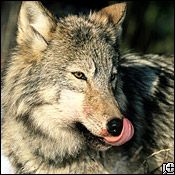The largest canid in the world, the gray wolf spends most of its life in packs, usually of five to ten individuals, that are led by the so-called alpha pair, the only male and female in the pack to breed.
Occasionally the wolf hunts and forages alone.
Advertisement
However, when preying on large animals such as moose and deer, it will hunt with the pack, using a variety of strategies, such as pushing its prey toward a rendez-vous point where other pack members wait in ambush.
The wolf uses a haunting howl to keep the pack together.
High-ranking adults also communicate by scent-marking with urine and feces.
Advertisement
